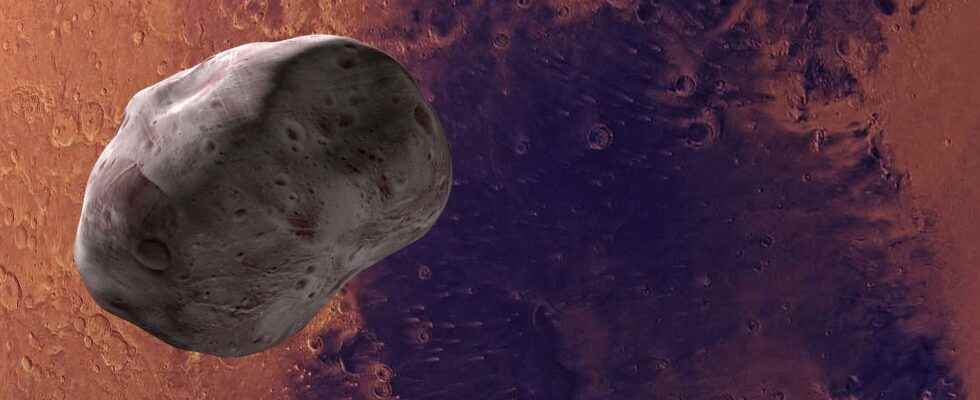The Mars Express probe, orbiting the Red Planet since 2003, observed the reflection of charged particles contained in solar winds during two flyovers of the moon Phobos. The European Space Agency has thus carried out several operations in order to study more precisely the environment of Phobos.
The moon martian Phobos intrigue them astronomers, to the point of mobilizing the Mars Express probe. L’European Space Agency (ESA) published a press release on 2 December detailing the flyovers carried out by Phobos’ Mars Express, and the data collected by the device. Since arriving in Red Planet orbit in December 2003, Mars Express has observed the repair of particles projected by the solar winds. ESA is therefore seeking to understand this natural satellite, whose characteristics seem comparable to those of the Moon.
Strange interactions with the solar wind
Launched in 2003, Mars Express has since carried out numerous overflights of Phobos, which orbits just 6,000 kilometers from the ground of Mars. The characteristics of Phobos are relatively similar to those of the Moon, despite some notable differences. Thus, if the diameter of Phobos is 22.5 kilometers (against 3,473 kilometers for the Moon), they are rocky bodies without atmosphere no magnetic field.
The Moon reflects the particles ofenergies charged emitted by solar winds. The latter project plasma composed ofelectrons and D’ions, which can degrade electronic equipment in space and pose a risk to astronauts. The Earth is protected from these flows thanks to his magnetic field, but the Moon regularly faces these charged particle winds, even though the earth’s magnetic field can sometimes act as a protective shield.
During one of his overflights of Phobos in 2008, Mars Express was thus able to observe the reflection of charged particles on the surface of the natural satellite. This phenomenon was repeated eight years later, in 2016. Researchers from ESA and the Nasa then noted the weak frequency occurrence of this phenomenon, and then attributed it to a possible reflection made by the probe itself. Astronomers therefore devised a maneuver to determine whether Mars Express was indeed responsible for the facts observed in 2008 and 2016.
“False overflights”
In 2017, the ESA therefore carried out “false overflights” (fake flybys in English) in order to verify the theory of reflection caused by Mars Express. The engineers of the space agency thus repeated the same maneuvers than in 2008 and 2016, with similar parameters (position of solar panels, calibration instruments…). Mars Express passed through an area swept by solar winds, however without observing Phobos. These false flyovers demonstrated that the probe neither produced nor reflected charged particles from the Sun. The researchers therefore believe that the data collected in 2008 and 2016 could attest to the reflection of solar winds at the surface of Phobos.
The mystery remains however concerning the differences of interactions of the solar wind between the Moon and Phobos. Doctor Yoshifumi Futaana, having worked on a study on the overflight of Phobos in 2016, explains in the ESA press release: ” to learn more, we need to do more Phobos flyovers with Mars Express, in different configurations. Even if we do not observe a reflection of charged particles, it will give us more information about the environment of the natural satellite ”.
Interested in what you just read?
.
fs3
